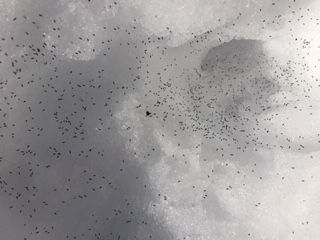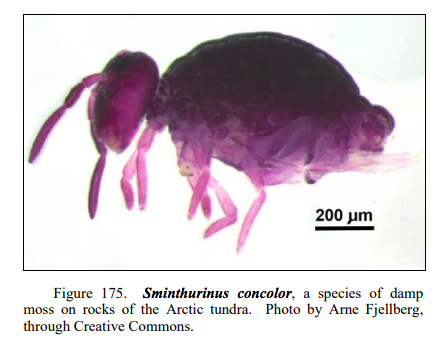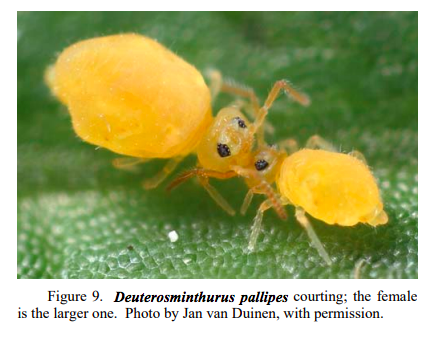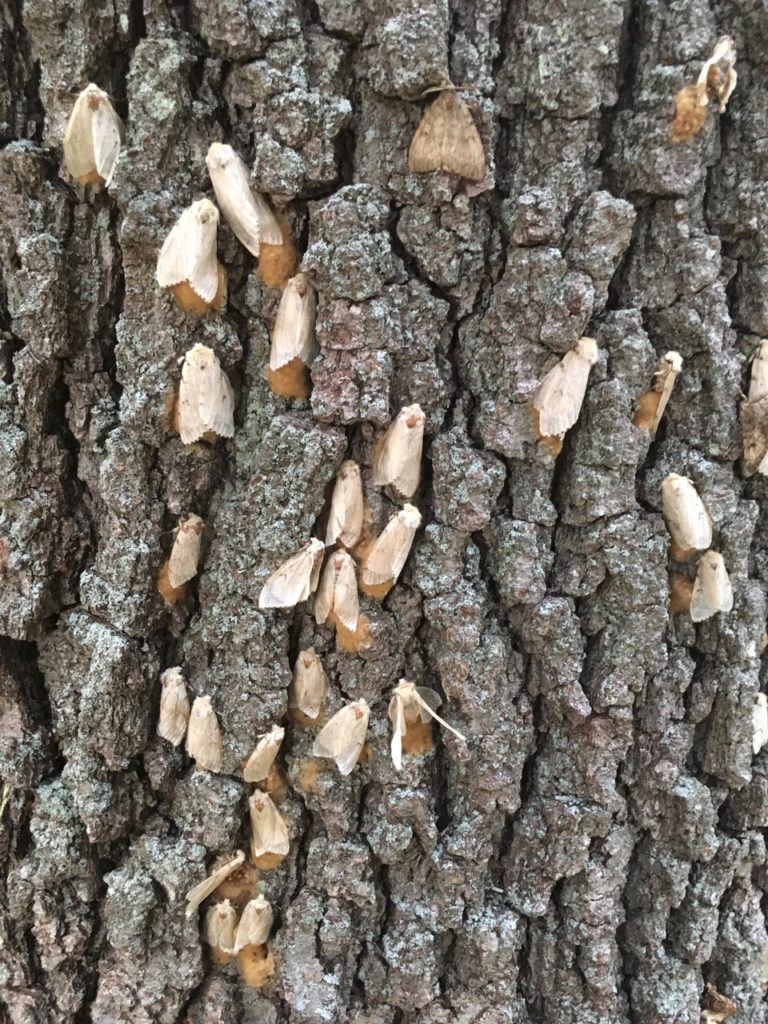
Gypsy moth females crowd the trunk of an oak in Ipswich MA. Each female is laying between 500-1000 eggs in a tan mass. Photo credit: Craig Story
I was on the phone with an alumn recently, talking biology and teaching when he asked about something he was hearing. It was like rain, he said. It was constant. It was caterpillars eating all of the leaves on his trees, his neighbors’ trees, the trees for miles around. Their chomping and the delicate fall of their dry droppings (frass) made a gentle but continuous noise. “Why are they so bad this year?” he asked.
Lots of people have been asking me that and other questions such as,
“Why are my oaks all dying?” Here is a quick answer: gypsy moths.
Gypsy moths (Lymantria dispar) are, not surprisingly, in the Lepidoptera (moths and butterflies) order of insects. They are in a group called the tussock moths. They hatch from eggs into caterpillars on trees and shrubs and eat leaves in the spring, eventually molting several times. Then the gypsy moth caterpillars pupate, emerge as adults, mate and the females lay eggs. The males have functional brownish wings. You may see them flying about in an oddly jerky way while they follow the mesmerizing scent of a female. The females don’t fly. They just wait with white, unusable wings, on the trunks of trees. Later the females will lay masses of eggs in what looks like a fuzzy, spongy tan packet on trees and picnic tables and where ever else strikes their fancy.
Why are Gypsy moths here?
Gypsy moths came originally from Europe and Asia. Unfortunately, in 1869 they were purposely imported by someone who wanted to use them for silk production. The caterpillars do make small amounts of silk, so the wind can catch the silk threads and distribute caterpillars from tree to tree. However, the silk experiment did not go as intended. Today, we do not have a thriving silk industry from gypsy moths and unfortunately, the moths have become a huge pest in many parts of North America.
Because they did not evolve in North America, gypsy moths have few natural controls such as diseases, predators and parasites. Unfortunately, gypsy moths voraciously eat 500 different host plants (their favorites are oaks), and can destroy hardwood forests. The worst infestation in New England was in the 1980s but the last few years have been pretty bad as well.
Why so bad right now?
Gypsy moths naturally have outbreak and die-off cycles. A drought in 2016 weakened trees and also killed a fungus that can infect moth larvae. This meant that gypsy moth populations reached high numbers in 2017. Gypsy moths are killed by deep cold, thus recent warmer winters have had an effect. In 2018 we actually have fewer moths in Massachusetts than we did in 2017. However, as my phone caller described, because of uneven distribution of moths, some places (including nearby Ipswich) have had incredible densities of gypsy moths.
Most trees can handle a single defoliation. In fact, a small infestation of leaf-eating caterpillars is a good thing. It can open up forest floor for growth, provide food up the food chain, and fertilize the soil. However, when several years of annual defoliation pass and a drought has stressed them, even huge hardwoods can die. The forest floor can be so opened that invasive species move in, and valuable wood as well as ecosystem functions can be lost.
What can kill gypsy moths?
There are some predators and pathogens that can knock the moths back. For example, viruses can infect gypsy moths. One virus in particular, (the nucleopolyhedrosis virus) can stop an outbreak by killing off much of the moth population. Like the virus, a major fungal pathogen (Entomophaga maimaiga) is also more likely to spread when caterpillars are very crowded and the weather is wet.
In years when gypsy moths are less common, mammals and birds help keep the moths under control. The little white footed mouse munches away on pupae, adults and larvae, even climbing trees to find them. The short-tailed shrew eats moths voraciously. Even squirrels get into the act. At least 14 species of birds are known to eat them as well.
There are several “bugs” (used the way normal people, not entomologists, use this word) that eat gypsy moths; ladybird beetles, wasps, and spiders are a few examples. Two insect predators need special mention. The parasitic fly, Compsilura concinnata, was released in the US in 1906 to kill the gypsy moth. It was brought from its native Europe. The fly is quite effective at killing insect hosts. The larvae eat the body of the host on which they have been laid. Then they pupate, and as adults, mate and parasitize more hosts, in three or four generations a year. Because the gypsy moth has only one generation per year, the parasitic fly has to live on other insects as well. (Poor planning by the people who released it!) Indeed, the fly can parasitize 200 species of insects. Unfortunately their prey include native species like the giant silk moths, such as the Luna.
The adults of a large, ground beetle (Calosoma sycophanta) eat gypsy moth larvae, and the larval beetles seek out and feed on the moth pupae. The beetle is large and iridescent and spectacularly beautiful. While it does eat several other moth species, the ones it eats are often invasive.
What Can I do?
The gypsy moth caterpillar season is over for 2018 and the adults don’t feed. Trying to trap the males, which is possible, is unlikely to be effective. You can scrape egg masses off of trees, but if you do so, don’t just let them drop onto the ground where some eggs may survive, but knock them into a can of soapy water. The biggest thing you can do is try to prevent the caterpillars from defoliating your trees next spring.
While pesticides can sometimes be used against Gypsy moths, in general the chemicals have to hit each individual caterpillar or egg, and this coverage is very hard to achieve in tall trees. Pesticides can also kill non-target organisms including predators of the moths, which obviously is the opposite of your goal. So for very particular lawn trees, spraying might be useful but its effectiveness is limited. Pesticides are much more effective on small trees, such as you might find in an orchard, especially early in the caterpillars’ growth.
Early in an infestation, small caterpillars can be treated successfully with Bacillus thuringiensis (kurstaki), commonly known as B.t.k.. This is a bacterium that makes a toxin that kills certain types of insects. A certified pest control operator with tree top equipment would need to apply the solution, but this option can be effective. When infestations are not at high levels, trapping caterpillars on tree trunks in either burlap trap or a sticky barrier can help keep caterpillar damage down.
Gypsy moths offer a cautionary tale about releasing organisms in parts of the world where they don’t normally occur. Here, we’ve managed to have forests in spite of a number of invasive insect pests. The impact of climate change is a yet unknown force, however, and we have still to see what will result.
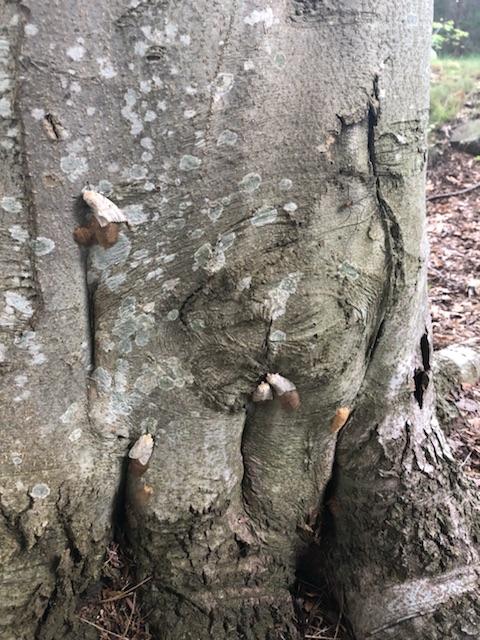
Gypsy moth females on a tree trunk in Annisquam, MA, July 21, 2018 photo credit: Alexa Bragg
For More information
https://ag.umass.edu/landscape/fact-sheets/gypsy-moth
http://www.gypsymothalert.com/control.html
https://www.massaudubon.org/learn/nature-wildlife/insects-arachnids/nuisance-moths/gypsy-moths
https://ag.umass.edu/landscape/news/gypsy-moth-caterpillar-feeding-finished-for-2018
http://www.courant.com/community/brooklyn/hc-kn-brooklyn-gypsy-moth-devastation-killing-trees-in-eastern-ct-0524-20180521-story.html
https://www.fs.fed.us/ne/morgantown/4557/gmoth/
https://en.wikipedia.org/wiki/Calosoma_sycophanta
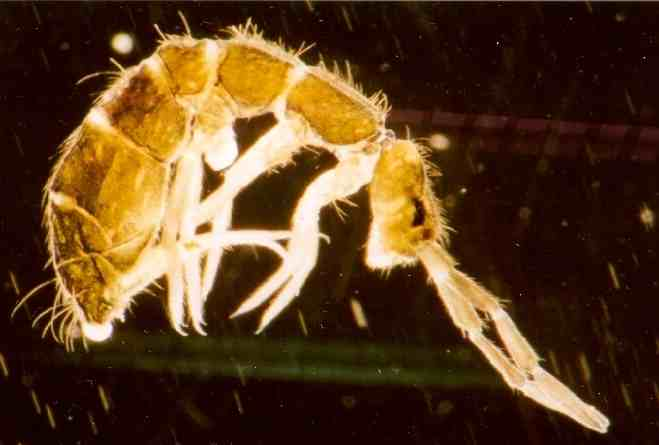 (from U. Burkhardt, under a Creative Commons license):https://en.wikipedia.org/wiki/File:Isotoma_Habitus.jpg
(from U. Burkhardt, under a Creative Commons license):https://en.wikipedia.org/wiki/File:Isotoma_Habitus.jpg
